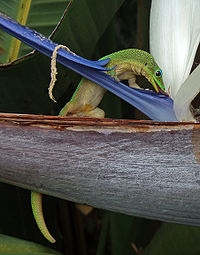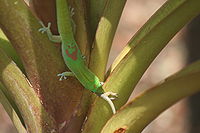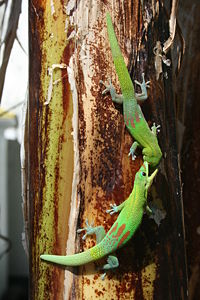
Gold dust day gecko
Encyclopedia
Gold dust day gecko is a diurnal
subspecies
of gecko
s. It lives in northern Madagascar
and on the Comoros
, it has been also introduced to Hawaii
and other Pacific islands. It typically inhabits various kinds of trees and houses. The Gold dust day gecko feeds on insect
s and nectar.
The Gold dust day gecko inhabits the northern part of Madagascar
. It can also be found on the island of Nosy Bé
, the Comoros
and Réunion
island. According to McKeown [2], this species has also been introduced to the Seychelles
, and onto the Hawaiian Islands
, where it is established on both sides of O'ahu, the Kona
side of the Big Island
, and on Maui
. It has also been spotted on Kauai
and the eastern tip of the Big Island
.

 These day geckos feed on various insects and other invertebrates, and are also capable of eating other smaller lizards. They also eat soft, sweet fruit and pollen and nectar from flowers, often congregating in groups of many individuals to feed off of one plant.
These day geckos feed on various insects and other invertebrates, and are also capable of eating other smaller lizards. They also eat soft, sweet fruit and pollen and nectar from flowers, often congregating in groups of many individuals to feed off of one plant.
 The males of this species are rather aggressive and can be quite quarrelsome. They do not accept other males in their territorry. In captivity, where the females cannot escape, the males may also seriously wound a female. In this case the male and female must be separated.
The males of this species are rather aggressive and can be quite quarrelsome. They do not accept other males in their territorry. In captivity, where the females cannot escape, the males may also seriously wound a female. In this case the male and female must be separated.
. At a temperature of 28°C, the young will hatch after approximately 40–45 days. The juveniles measure 55–60 mm. They should be kept separately since even the juveniles can be quite quarrelsome. Sexual maturity is reached after 10–12 months.
Diurnal animal
Diurnality is a plant or animal behavior characterized by activity during the day and sleeping at night.-In animals:Animals that are not diurnal might be nocturnal or crepuscular . Many animal species are diurnal, including many mammals, insects, reptiles and birds...
subspecies
Subspecies
Subspecies in biological classification, is either a taxonomic rank subordinate to species, ora taxonomic unit in that rank . A subspecies cannot be recognized in isolation: a species will either be recognized as having no subspecies at all or two or more, never just one...
of gecko
Gecko
Geckos are lizards belonging to the infraorder Gekkota, found in warm climates throughout the world. They range from 1.6 cm to 60 cm....
s. It lives in northern Madagascar
Madagascar
The Republic of Madagascar is an island country located in the Indian Ocean off the southeastern coast of Africa...
and on the Comoros
Comoros
The Comoros , officially the Union of the Comoros is an archipelago island nation in the Indian Ocean, located off the eastern coast of Africa, on the northern end of the Mozambique Channel, between northeastern Mozambique and northwestern Madagascar...
, it has been also introduced to Hawaii
Hawaiian Islands
The Hawaiian Islands are an archipelago of eight major islands, several atolls, numerous smaller islets, and undersea seamounts in the North Pacific Ocean, extending some 1,500 miles from the island of Hawaii in the south to northernmost Kure Atoll...
and other Pacific islands. It typically inhabits various kinds of trees and houses. The Gold dust day gecko feeds on insect
Insect
Insects are a class of living creatures within the arthropods that have a chitinous exoskeleton, a three-part body , three pairs of jointed legs, compound eyes, and two antennae...
s and nectar.
Description
This lizard belongs to the smaller day geckos, and can reach a total length of about 6-9 inches. The body colour is a bright green or yellowish green or rarely even blue. Typical for this day gecko are the yellow speckles on the neck and the upper back. There are three rust-coloured transverse bars on the snout and head; the upper part of the skin around the eye is blue. On the lower back there are three tapering red bars. The tail is slightly flattened. The under side is off-white.The Gold dust day gecko inhabits the northern part of Madagascar
Madagascar
The Republic of Madagascar is an island country located in the Indian Ocean off the southeastern coast of Africa...
. It can also be found on the island of Nosy Bé
Nosy Be
Nosy Be is an island located off the northwest coast of Madagascar. Nosy Be is Madagascar's largest and busiest tourist resort. It has an area of 312 km2 and its population was officially estimated at 36,636 in 2001....
, the Comoros
Comoros
The Comoros , officially the Union of the Comoros is an archipelago island nation in the Indian Ocean, located off the eastern coast of Africa, on the northern end of the Mozambique Channel, between northeastern Mozambique and northwestern Madagascar...
and Réunion
Réunion
Réunion is a French island with a population of about 800,000 located in the Indian Ocean, east of Madagascar, about south west of Mauritius, the nearest island.Administratively, Réunion is one of the overseas departments of France...
island. According to McKeown [2], this species has also been introduced to the Seychelles
Seychelles
Seychelles , officially the Republic of Seychelles , is an island country spanning an archipelago of 115 islands in the Indian Ocean, some east of mainland Africa, northeast of the island of Madagascar....
, and onto the Hawaiian Islands
Hawaiian Islands
The Hawaiian Islands are an archipelago of eight major islands, several atolls, numerous smaller islets, and undersea seamounts in the North Pacific Ocean, extending some 1,500 miles from the island of Hawaii in the south to northernmost Kure Atoll...
, where it is established on both sides of O'ahu, the Kona
Kona District, Hawaii
Kona is the name of a moku or district on the Big Island of Hawaii in the State of Hawaii. In the current system of administration of Hawaii County, the moku of Kona is divided into North Kona District and South Kona District . The term "Kona" is sometimes used to refer to its largest town,...
side of the Big Island
Hawaii (island)
The Island of Hawaii, also called the Big Island or Hawaii Island , is a volcanic island in the North Pacific Ocean...
, and on Maui
Maui
The island of Maui is the second-largest of the Hawaiian Islands at and is the 17th largest island in the United States. Maui is part of the state of Hawaii and is the largest of Maui County's four islands, bigger than Lānai, Kahoolawe, and Molokai. In 2010, Maui had a population of 144,444,...
. It has also been spotted on Kauai
Kauai
Kauai or Kauai, known as Tauai in the ancient Kaua'i dialect, is geologically the oldest of the main Hawaiian Islands. With an area of , it is the fourth largest of the main islands in the Hawaiian archipelago, and the 21st largest island in the United States. Known also as the "Garden Isle",...
and the eastern tip of the Big Island
Hawaii (island)
The Island of Hawaii, also called the Big Island or Hawaii Island , is a volcanic island in the North Pacific Ocean...
.
Diet


Behavior

Reproduction
The females lay up to 5 pairs of eggsEgg (biology)
An egg is an organic vessel in which an embryo first begins to develop. In most birds, reptiles, insects, molluscs, fish, and monotremes, an egg is the zygote, resulting from fertilization of the ovum, which is expelled from the body and permitted to develop outside the body until the developing...
. At a temperature of 28°C, the young will hatch after approximately 40–45 days. The juveniles measure 55–60 mm. They should be kept separately since even the juveniles can be quite quarrelsome. Sexual maturity is reached after 10–12 months.

